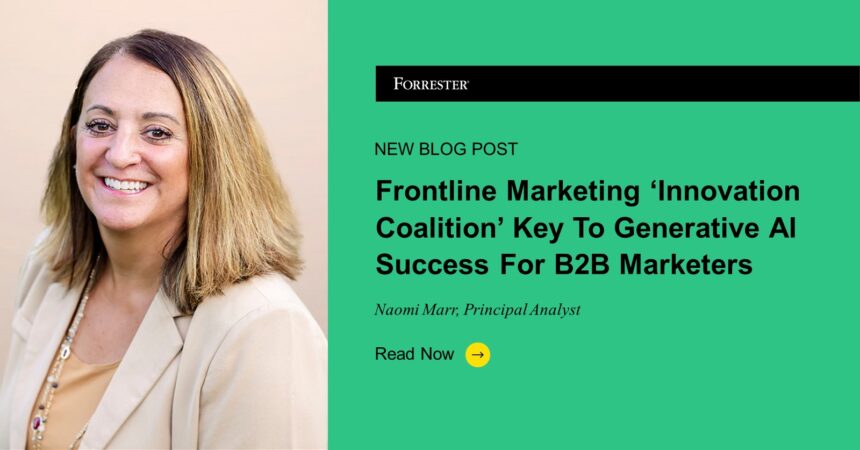It is no exaggeration to say that generative AI (genAI) is everywhere these days, or that every function inside firms is scrambling to understand their company’s AI policies to avoid being out of compliance; to test the new technology to understand if it offers any competitive advantage; and to meet with agency and vendor partners to understand their new genAI services or planned features. The frontline marketing function (demand, account-based, digital, field, and customer marketing) is no different. But it is also the function predicted to be impacted first, because most early genAI applications are focused on content and art creation, which is critical to success in B2B marketing.
Unlike some functions (i.e., application development teams with agile development methodologies), frontline marketing workflows are traditionally very messy, spanning siloed teams. It takes a Herculean effort to leverage new features from vendor partners or to roll out new technology or processes, placing frontline marketing in a precarious position regarding generative AI. And frontline marketing functions with weak innovation motions are especially vulnerable to missing the opportunity to evolve, which can be seen as a conflict with their responsibility for consistent revenue growth. Additional forces such as data deprecation and signal loss, measurement ambiguity, discipline convergence, and complex data requirements make innovation that much harder. Even the most forward-leaning frontline marketing teams that embrace lifecycle revenue marketing (LRM) may not have a strong innovation motion, making the exploration of the impact of big data and generative AI on the customer experience disjointed and poorly managed.
So what is a frontline marketing function to do?
Create an “innovation coalition.” Think of it as a demand center focused on frontline marketing innovation. It is a cross-functional group from demand, account-based marketing, digital, field, customer marketing, and event or partner marketing if applicable. The coalition is responsible for identifying, testing, rolling out, and enabling innovative opportunities for frontline marketing. The goal of the coalition is to improve customer experience and help marketing meet revenue objectives by leveraging new innovations.
The first task of this innovation coalition is to document every cross-functional frontline marketing touchpoint across the customer lifecycle (from prospect all the way through to renewal, upsell, cross-sell, and expansion). This effort is often tabled because it seems a daunting task. Start simply. Document, with a single notation (no need to go into detail), every touchpoint that the frontline marketing team has pushed across the customer lifecycle over the prior three months. You will need to consider industries, countries, go-to-market motions, product specifics, and audience segment. The outcome of this exercise is a better holistic understanding of frontline marketing’s impact on the customer experience and opportunities for better alignment and coordination. Even if this is the only task the team undertakes, better understanding of the customer experience will be worth it.
The second task of the coalition is to process-map the marketing workflow, no matter how ugly it may be. It is best to map the processes based on the Forrester B2B Marketing Process Value Chain, which groups activities by strategy, plan, design, build, activation, measurement, and optimization, and to cover all the various assets, channels, and tactics. The process and technology ugliness must be accepted and documented to avoid unintentionally exacerbating the situation.
The third task is the process of understanding generative AI — pros and cons as well as how and where it might be leveraged within the existing customer journey, process map, and technology stack. It is imperative to understand the company’s position on genAI use prior to any testing. The outcome of this effort should be a roadmap to ensure that selected innovations are successful. Note that no one is working with a common dataset, so anything produced using generative AI will be dependent on the data behind it. A data strategy across generative AI applications or features focused on capturing data important to the company is essential.
It is for this reason that the fourth task of the innovation coalition must be to enable frontline marketing to understand, make good decisions about, and use big-data best practices. Build basic data-mapping understanding. Data mapping is the process of matching fields from multiple datasets (usually housed in different applications or data warehouses/lakes) into a schema, or centralized “map,” that shows the relationships between the fields. The downstream effect is cleaner: more usable data for addressing customer needs. If frontline marketers fail to improve their skill set in this area, it will further exacerbate the complexity of processes and the technology stack, having a direct impact on customer experience.
Once the “innovation coalition” is formed, it should be retained and extended to other areas of innovation. An LRM-focused frontline marketing organization must continuously upskill and reskill teammates — and continue to innovate — all in the name of the customer experience.
Forrester clients can reach out to schedule a guidance session with me to go deeper on the practical implementation of an innovation coalition or to cover any other topics related to organizational structure and performance, team skills and capabilities, or change management.








